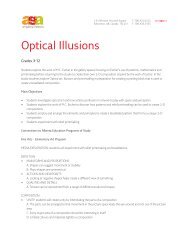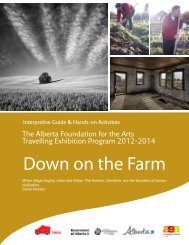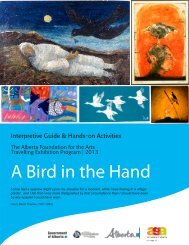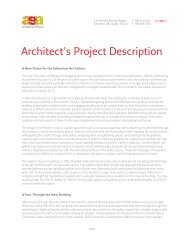Urban Animals - Art Gallery of Alberta
Urban Animals - Art Gallery of Alberta
Urban Animals - Art Gallery of Alberta
Create successful ePaper yourself
Turn your PDF publications into a flip-book with our unique Google optimized e-Paper software.
The <strong>Alberta</strong> Foundation for the <strong>Art</strong>s Travelling Exhibition Program<br />
Charcoal Cave Drawings K-6, continued<br />
Procedure:<br />
1. Give the student some background information on Cave <strong>Art</strong> by reading the background<br />
information provided in the ed kit or doing internet searches on “Lascaux Caves France”. Or,<br />
you can check out books at the library that have pictures for the student to reference.<br />
2. Prepare Drawing Surface: Use brown paper grocery bags for the drawing surface. Make one<br />
cut down the side <strong>of</strong> the bag and cut <strong>of</strong>f the bottom, to make the largest drawing surface. Use<br />
the inside <strong>of</strong> the bag because it will not have advertising printed on it. Flatten out the bag into a<br />
drawing surface. Tear <strong>of</strong>f some <strong>of</strong> the straight edges <strong>of</strong> the bag so that it will look natural. Now,<br />
wrinkle up the bag into a big ball, unfold it and flatten with your hand to create the ridges that<br />
might be found on a cave wall.<br />
3. Drawing with Charcoal: Have students put on smocks to protect clothing from charcoal dust.<br />
(NOTE: The charcoal creates “dust” so remind the students not to blow it <strong>of</strong>f the paper as they<br />
work. They can carry the paper to a wastebasket to shake <strong>of</strong>f the dust.) Ask the students to<br />
draw some <strong>of</strong> the animals that they observed on the cave walls at Lascaux, France. They can<br />
start by drawing the outline <strong>of</strong> the animal, mimicking the textures <strong>of</strong> the drawings that they saw.<br />
Then, fill in all or just part <strong>of</strong> the body. Use thick lines, thin lines, drag the side <strong>of</strong> the chalk to<br />
make rough texture on the bumpy paper surface, or use fingertips to blend the charcoal into a<br />
smooth texture. Practice blending the different colours together.<br />
4. Completion: When students are satisfied with their drawing, ask them to describe it. Ask what<br />
techniques they used (thick or thin lines, blending or rough textures) to achieve the effects that<br />
they wanted. Then take the paper to a well ventilated location and apply fixative or hair spray to<br />
keep the charcoal or chalk from smudging too much.<br />
Materials:<br />
a variety <strong>of</strong> types <strong>of</strong> charcoal (brown, black and white)<br />
brown paper grocery bags<br />
photos <strong>of</strong> cave art in library books, OR from the internet<br />
moist paper towels<br />
spray fixative<br />
smocks, aprons or old shirts<br />
kids.inmatlock.com/origins/cave-painting.php<br />
AFA Travelling Exhibition Program, Edmonton, AB. Ph: 780.428.3830 Fax: 780.421.0479<br />
youraga.ca

















